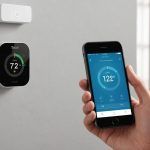Overview of Remote Desktop Functionality
Understanding remote desktop functionality is crucial in today’s remote work landscape. It enables efficient collaboration by allowing users to access and control a computer from a different location, as if they were seated right in front of it. This capability significantly enhances productivity by providing seamless remote connectivity to vital resources.
The Lenovo ThinkCentre M720q Tiny, with its compact design and robust performance, is ideal for remote access. It offers powerful computing solutions packed in a small footprint, making it perfect for both personal and business use. Its capabilities ensure consistent performance even when accessing heavy applications remotely.
Also to read : Top Strategies to Safeguard Your Data During File Transfers on Western Digital My Passport SSD
Mastering remote desktop connectivity comes with numerous benefits. For personal use, it offers the flexibility to access your home computer’s files and applications from anywhere. For businesses, it facilitates remote working arrangements, which can lead to increased employee satisfaction and improved operational efficiency. Efficiently utilising remote desktop solutions not only improves productivity but also allows for better data management and real-time collaboration across different locations.
In essence, leveraging remote desktop technology effectively positions users to make informed and strategic decisions, enhancing their ability to work and thrive in modern, dynamic environments.
Have you seen this : Unlock 4K Video Mastery: Fine-Tune Your HP Z2 Tower G5 for Ultimate Performance
Preparation for Setting Up Remote Desktop
Setting up a remote desktop on the Lenovo ThinkCentre M720q Tiny requires attention to system requirements, software installation, and configuring the proper settings. To ensure smooth remote connectivity, verify that your device meets a minimum of 4GB RAM and has an updated operating system such as Windows 10 or later.
Software installation begins with downloading reliable remote desktop software. Consider options like Microsoft Remote Desktop or TeamViewer, each offering user-friendly interfaces for seamless interaction. Once downloaded, follow the guided prompts for installation, ensuring to select any necessary plugins or drivers that enhance connectivity.
Prior to connecting, create optimal remote desktop settings. Begin by ensuring network readiness—verify strong internet connectivity and that firewall permissions allow remote access. Double-check network settings for both the remote device and the accessing computer.
An often overlooked step is configuring user permissions, enabling trusted personnel access while maintaining security. This involves setting up unique user credentials and ensuring that network permissions align with company policies.
By meeting these requirements and following setup guidelines, your Lenovo ThinkCentre M720q Tiny will be ready to handle remote access effectively, bridging any geographic gaps and enhancing productivity.
Step-by-Step Installation Guide
Installing Remote Desktop Software
The first crucial step is selecting the right remote desktop software for the Lenovo ThinkCentre M720q. Begin by visiting the software’s official website to download options like Microsoft Remote Desktop or TeamViewer. After downloading, initiate the installation by clicking the setup file. Follow the installation wizard, ensuring the ‘Install’ prompt is visible at all stages. It’s important to review any proposed settings or plugins that enhance connectivity during this process.
Configuring Remote Desktop Settings
Once the software is installed, configuring the remote desktop settings is next. You must adjust settings to maximise connection speed and stability. Start by ensuring that audio and video settings are optimally configured, reducing unnecessary data transmission. Moreover, you should adjust screen resolution to match or align with bandwidth capabilities.
Verifying Successful Installation
After configuration, testing the successful installation is essential. Confirm that all components work by accessing a device remotely. Verify connectivity by checking the interface response time and ensuring seamless access to files and applications. If you encounter any delays, review configuration settings again to pinpoint and rectify issues for exceptional remote connectivity.
Optimizing Configuration Settings
Enhancing remote desktop configuration is pivotal for achieving optimal performance and ensuring reliability. Initially, it’s essential to focus on key settings that will directly influence connection quality. Adjusting these configurations can significantly boost the efficiency of remote sessions and improve user experience.
Start by optimising visual settings. Lowering the screen resolution and colour depth can help reduce bandwidth usage, especially when dealing with limited network capacities. This will ensure smoother operations and faster response times. Next, tailor the audio settings. Disable unnecessary audio features that might be transmitting data and consuming bandwidth, unless they are crucial for the session.
For an enriched user experience, explore advanced features. Many remote desktop applications offer settings like clipboard sharing, file transfers, and multi-display support. Leveraging these can provide additional functionality and streamline workflows during remote access.
In conclusion, spending time on configuration optimization can lead to improved connection stability and general satisfaction during remote tasks. By fine-tuning these parameters, users can better enjoy the full range of capabilities provided by a remote desktop, making their interactions more productive and seamless. Proper optimisation paves the way for enhanced workflow and maximises the technological potential of the Lenovo ThinkCentre M720q Tiny.
Troubleshooting Common Issues
Remote desktop setups can be prone to a variety of common errors that impede seamless connectivity. Identifying and resolving these issues quickly is essential for maintaining productivity. Below, we delve into some of the most frequently encountered problems and their solutions.
Connection Failures are often due to poor network conditions or incorrect network settings. Before attempting a remote connection, ensure that both devices are on a stable internet connection. Additionally, verify that the firewall and router settings permit remote access. Incorrect user credentials can also lead to access denial, so double-check usernames and passwords.
Lagging or Poor Performance can be addressed by adjusting the visual and audio settings to minimize bandwidth consumption. Disable any unnecessary graphical features or sounds, and consider lowering the screen resolution for smoother operation.
If users encounter authentication errors, it might be due to incorrect permission configurations. Revisit user access controls to ensure they align with your company’s policies and that permissions are accurately configured.
For advanced troubleshooting support, it’s beneficial to refer to community forums dedicated to Lenovo ThinkCentre M720q and remote desktop solutions. Participation in these forums can provide additional insights and tailored advice for specific challenges.
Best Practices for Remote Desktop Security
Navigating the world of remote desktop safety demands a keen focus on effective security precautions. Remote connections inherently pose risks; thus, implementing security best practices is critical.
Firstly, always ensure your remote desktop software and the Lenovo ThinkCentre M720q Tiny are updated. Regular updates and patch management close vulnerabilities that cyber threats exploit. Never underestimate the power of keeping systems current.
Password policies play a crucial role in securing connections. Use strong, unique passwords and consider multi-factor authentication (MFA) to add a layer of protection. This extra step significantly reduces the risk of unauthorized data access.
Network security is vital. Employ firewalls and Virtual Private Networks (VPNs) to shield data traffic. Firewalls can block unauthorized access, while VPNs encrypt data, safeguarding sensitive information. Furthermore, configure user permissions attentively. Limit access based on roles, ensuring only essential personnel handle critical data.
Lastly, educate users on potential security threats, highlighting phishing and social engineering attacks. Encouraging a security-conscious culture mitigates risks and promotes better protective behaviour.
In essence, adopting these practices fortifies your remote desktop setup, ensuring secure and uninterrupted remote work experiences. Prioritizing security measures leads to resilient and safe remote connectivity.
Additional Resources and Tutorials
For individuals and businesses keen on mastering remote desktop configurations and achieving efficient remote connectivity, engaging with a range of remote desktop resources is vital. One noteworthy approach is to explore visual aids and tutorials that elucidate the complexities of remote desktops. Video tutorials often provide step-by-step guidance, making the installation and configuration process more manageable and accessible.
When selecting remote desktop software, it’s beneficial to consider platforms that offer comprehensive tutorials. Not only do these resources assist in setup, but they also provide insights into maximizing the software’s features for enhanced productivity. Recommended software includes options like Microsoft Remote Desktop and TeamViewer, known for their intuitive interfaces and robust support systems.
Furthermore, tapping into online communities and forums can be a game-changer. Engaging with fellow users provides real-world insights and solutions to specific hurdles, while also heeding advice from advanced users. Whether you’re resolving particular technical issues or refining your remote desktop settings, these resources are indispensable for ongoing learning and improvement.











